Jim Henson
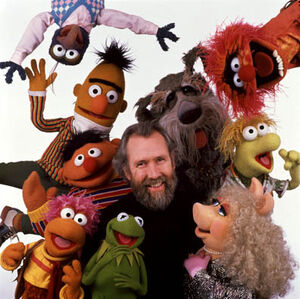
 Added by BradFraggle
Added by BradFraggle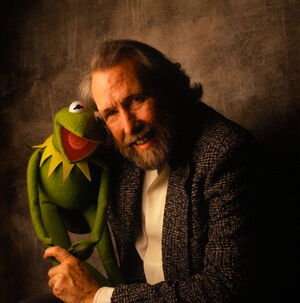
 Added by Scarecroe
Added by Scarecroe
 Added by Jbrangwynne53
Added by Jbrangwynne53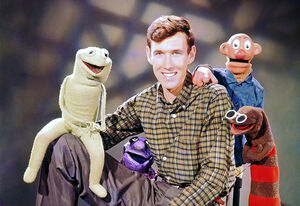
 Added by Warrick
Added by Warrick
 Added by Rocketstevo
Added by Rocketstevo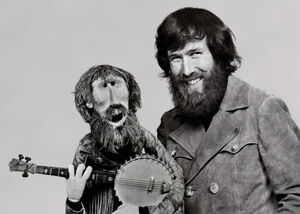
 Added by Scarecroe
Added by ScarecroeEarly Years
James Maury Henson was born in Greenville, Mississippi in 1936. Ten years later, in 1946, Henson moved with his family to Hyattsville, Maryland, a suburb near Washington, D.C.. While growing up, he loved watching Disney films and movies with comic legends like Bob Hope and George Burns, and enjoyed listening to such radio acts as Edgar Bergen and Charlie McCarthy. He would grow up to pay tribute to—and work with—many of these same legends. Henson graduated as a member of the National Honor Society from Northwestern Senior High School in Hyattsville, Maryland, on June 14, 1954.[1] Sam and Friends Edit
Edit
Henson made his earliest foray into television puppetry with friend and first puppeteering partner Russell Wall in the summer of 1954. The two created and performed the puppets Pierre the French Rat and Longhorn and Shorthorn for The Junior Morning Show on local station WTOP.[2] Although the show lasted only three weeks before being cancelled, Henson quickly landed a puppeteering job on the show Aftertnoon at NBC affiliate WRC-TV.[3] In 1955, while a college student at the University of Maryland, WRC-TV offered Henson his own show, resulting in the creation of Sam and Friends. The five-minute shows aired live twice a day after the news, and often involved the puppets lip-synching to a comedy or novelty record. Henson's co-puppeteer was the woman who would later become his wife, Jane Nebel. The two wed on May 28, 1959.[4] Of the cast of characters created for this series, only Kermit would remain as a major figure with Jim Henson for later productions.
Jim Henson made several important innovations in terms of how puppets were used on TV. The first is that he did away with tiny one-hand puppets whose heads only bobbed when they talked, preferring instead to use puppets with moving mouths and often real hands. The second innovation was to get rid of the stage that all puppets on TV hid behind, just as they did in conventional theater. He wisely realized that the TV screen itself is the stage. Freeing the puppets from the constrictions of the past, Henson found that the characters were able to move around their environment in a much more imaginative and exciting way.
Beginning in the late 1950s, while still producing Sam and Friends, Henson kept his fledging company afloat by using his puppets in TV commercials. Early forays included Wilkins and Wontkins and other characters for local companies, under the name "Muppets Inc.", formed in 1958. By the 1960s, the burgeoning Muppets Inc. had expanded to national campaigns, and one of the characters created for these commercials was Rowlf the Dog. Rowlf helped Henson get nationwide attention for the first time by appearing in regular comedy bits on The Jimmy Dean Show. This led to increased appearances by the Muppets on variety shows and talk shows, including Today and The Ed Sullivan Show.
During this time, Jim Henson met and hired two more people who would become enormously important to his work: Frank Oz, who Henson once called "absolutely the greatest puppeteer in the world"[5] and Jerry Juhl, who would have a hand in writing nearly every Muppet production for 35 years. In 1962, Don Sahlin also joined the Muppets, building Rowlf and laying the foundations for the Muppet Workshop. Apart from puppetry, Henson also experimented as an animator and filmmaker, with such films as the 1965 Academy Award nominated short Time Piece (which he wrote, directed, and starred in), several comedic industrial films (paving the way for the Muppet Meeting Films), the documentary Youth '68, and the hour-long experimental drama The Cube in 1969.
Sesame Street Edit
Edit
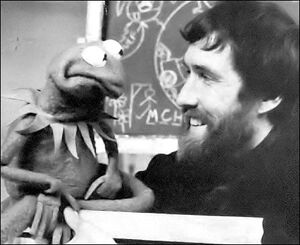
 Added by MuppetDanny
Added by MuppetDanny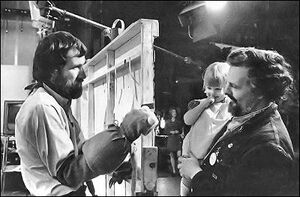
 Added by MuppetDanny
Added by MuppetDanny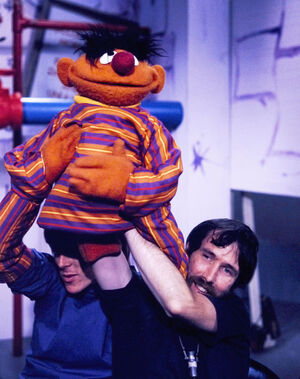
 Added by Jbrangwynne53
Added by Jbrangwynne53Jim Henson was initially reluctant to use his characters on an educational kids' series, for fear of being typecast as a children's entertainer.[6] However, Joan Ganz Cooney, once remarked that while the show's creative team had a collective brilliance, Henson was the only "individual genius.": "He was our era's Charlie Chaplin, Mae West, W.C. Fields and Marx Brothers," Cooney said, "and indeed he drew from all of them to create a new art form that influenced popular culture around the world."[7]
On Sesame Street, Jim Henson performed Kermit the Frog, the only major established Muppet to appear regularly on the new series (although Rowlf made one cameo). He also performed such new characters as Ernie and game show host Guy Smiley. Continuing his penchant for animation and live film-making, Henson wrote and directed such inserts as the Number Song Series that always ended with a baker falling down the stairs (Henson dubbed the voice, even though a different actor portrayed the baker) and several animated shorts, including "King of 8", "Queen of 6", and "Eleven Cheer." He also built the dollhouse seen in the Dollhouse film. According to season two research studies found in CTW Archives files, "All of the Henson films are extremely effective in getting the children to watch and to participate. The involvement of children viewing these films is remarkable."
Although increasingly individuals like Don Sahlin, Kermit Love, and other Muppet Workshop employees gained greater responsibility for character development, Henson still supplied the initial sketches for many of the key characters, including Ernie, Bert, and The Amazing Mumford. As evidenced in Jim Henson's Designs and Doodles, while Love and Sahlin built Big Bird, Henson devised the initial concept of a full bodied character, and supplied sketches showing how he would be performed.
By the late-1970s/ early 1980s, he became more involved with other projects, and therefore mainly just performed his characters in inserts rather than in the main street plots. However, he was still involved in related productions, performing his characters in the first Sesame Street movie, Follow That Bird, performing his characters' voices in various Sesame Street Live shows, and also performing in Christmas Eve on Sesame Street, Big Bird in China, Don't Eat the Pictures: Sesame Street at the Metropolitan Museum of Art, The Sesame Street Special, and Sesame Street: 20 and Still Counting. In the last production mentioned, Henson also appeared as himself in two scenes. He was also interviewed on The Sesame Street Experiment and Sing! Sesame Street Remembers Joe Raposo and His Music.
Jim Henson's last segments for the show were taped on November 21, 1989. Henson's later performances include a Sesame Street News Flash segment in which Kermit interviews a bird whose parents live in different trees, Kermit's song "I Wonder 'Bout the World Above Up There", and Ernie's song "Don't Throw That Trash on the Ground".[8]
The Muppet Show
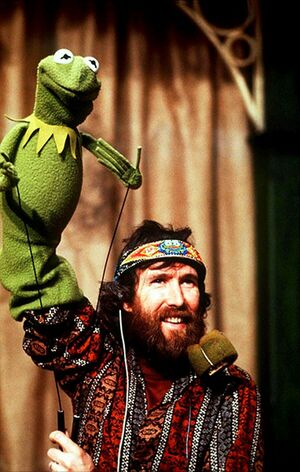
 Added by Warrick
Added by Warrick
 Added by MuppetDanny
Added by MuppetDanny
 Added by Scarecroe
Added by Scarecroe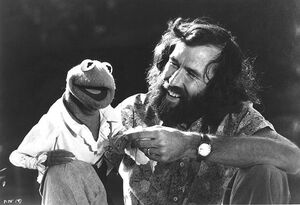
 Added by BradFraggle
Added by BradFragglePerformers who joined Henson's ever-growing team during this period include Dave Goelz, Louise Gold, and Steve Whitmire.
Henson created another innovation starting with The Muppet Show: from now on, all productions would be platformed up, so that humans could move about freely and interact convincingly with the puppets, while the puppeteers could remain easily hidden, and move about their environment with even greater fluidity than before.
In 1979, Jerry Juhl described Henson's unique working style in an article about the making of The Muppets Go Hollywood special: "The [production assistants] are running around screaming, 'How are we ever going to do all this?' And Jim is wandering around in the middle of it all, perfectly calm, perfectly content. You go to him and ask, 'How's it going?' And he says, 'Oh, fine. There were hardly any airplanes overhead when we filmed Miss Piggy by the pool.' He's just like Kermit -- if The Muppet Show had a basketball team, the score would always be Frog 99, Chaos 98." [9]
The Muppet Show was so successful that it spawned three movies during Henson's lifetime (and more since): The Muppet Movie, The Great Muppet Caper, and The Muppets Take Manhattan. Each film provided Henson with further opportunities to break technological barriers, including allowing Kermit to ride a bike.
Fantasy Films
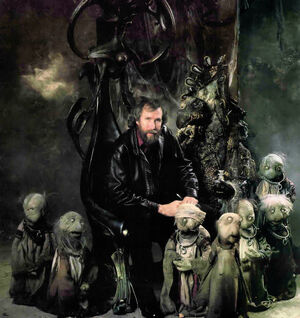
 Added by MuppetDanny
Added by MuppetDannyBased on what he and his team learned from their experiences on The Dark Crystal, Jim Henson founded the Creature Shop to create new characters both for Henson movies and for outside productions. In-house productions during his lifetime included Labyrinth and The StoryTeller, while outside productions included Dreamchild, The Bear, Teenage Mutant Ninja Turtles, and The Witches.
Fraggle Rock Edit
Edit
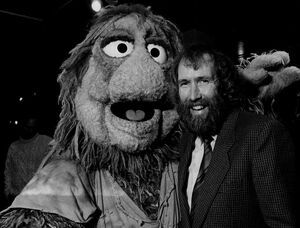
 Added by Gribbaziggy
Added by Gribbaziggy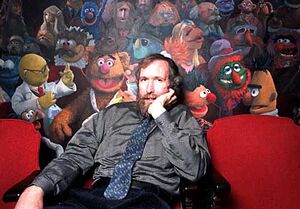
 Added by Scooter
Added by ScooterAlthough very much involved in the series as a creator, and serving as a director on several episodes, by this point Jim Henson was becoming increasingly "hands-off" as a performer and beginning to look at ambitious "realistic" puppet projects, instead assigning the regular roles to The Muppet Show veterans as well as up-and-comers and Canadian talent. However, his very occasional appearances on Fraggle Rock showcased two scene-stealing characters, the enigmatic, "implacably calm" Cantus the Minstrel, who represented Henson's Zen-like beliefs and musical interests, and the flamboyant, fast-talking Convincing John, representing Henson's more frenetic, showman qualities.
The Jim Henson Hour
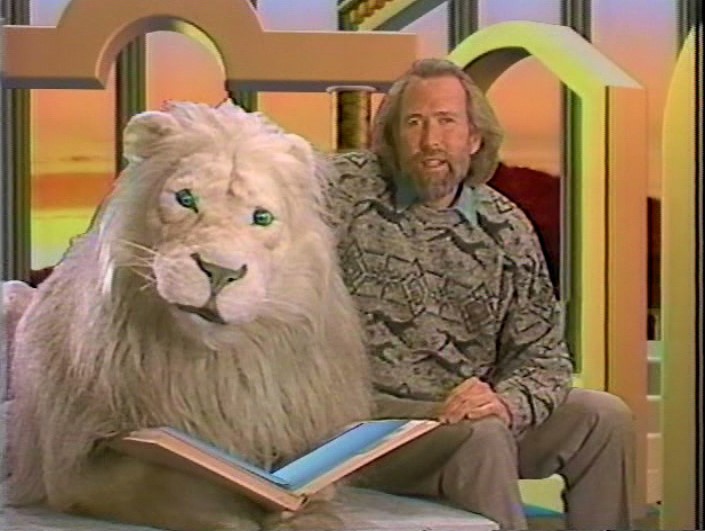
 Added by Scarecroe
Added by ScarecroeOn The Jim Henson Hour, Jim Henson appeared as himself in introductions and closings for the show. He hosted Jim Henson Hour pitch tape and The Secrets of the Muppets. Jim Henson also won an emmy for directing one special featured in this series, Dog City. Although most of his major characters from The Muppet Show made at least one appearance on The Jim Henson Hour, Henson did not perform any new recurring characters in the series.
No comments:
Post a Comment